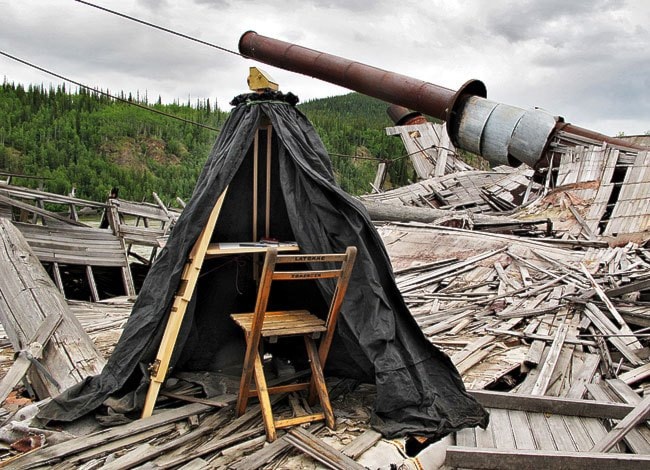Long before we took photography for granted by snapping selfies and pictures of our meals at whim, people would once gather inside strange shelters and marvel at moving images projected onto a flat surface.
Anyone walking by the SS Klondike on Thursday and Friday evening this week can experience this form of antiquated entertainment, called a camera obscura.
Donald Lawrence, a visual arts professor at Thompson Rivers University in Kamloops, B.C., will be setting up a tent-like version of the camera and offering workshops on both nights.
Participants will use the images projected onto a large drawing board to sketch their surroundings. Some of the work will be exhibited in the community gallery space at the Yukon Arts Centre.
It’s part of the lead up to the upcoming Midnight Sun Camera Obscura Festival, held in Dawson City on June 17-21.
The camera obscura was initially used in the 15th and 16th centuries by artists to help them draw their subjects more accurately, but it also became popular among scientists, who used them to observe solar phenomena.
Think of a cross between a giant pinhole camera and a periscope. Light shines into a dark chamber at the top of a structure and bounces off a mirror downwards and onto a flat surface.
The camera obscura’s popularity peaked in the late 19th century, when elaborate versions of the device were built to offer 360-degree views, and became used for entertainment purposes at fairs and tourist attractions in areas such as Central Park, San Francisco and England.
Lawrence estimates he’s built about a half-dozen camera obscuras so far. The first was a walk-in camera he set up when he was a graduate student at York University in Toronto, while another featured a hooded structure on top of a kayak.
“My things tend to be more experimental,” he said.
The interest in the camera came from an art class he took during his BFA at the University of Victoria, around 1985.
“My drawing instructor noticed that I had an interest in spatial relationships between foreground and background objects,” he said.
“He was a photographer and he loaned me a view camera, the ones where you put the hood on the back of your head. Around the same time I also became interested in art history from the 17th century and that research led me to finding out about public camera obscuras.”
Some artists are interested in them because of the way they affect the quality of light, he said, while others are more interested in the historical aspect and how it is tied to colonialism.
But there is enough middle ground for people from both backgrounds to come together and enjoy what it has to offer, he added.
The workshops in Whitehorse and festival in Dawson City are tied to a larger, five-year initiative called The Camera Obscura Project. Lawrence is the group’s principal investigator.
“The aim is to bring together this group of people from diverse backgrounds as a research group, to exchange ideas and understand each other’s practices,” Lawrence said.
“Last year the group came together to meet in a seminar format to show one another what they do, and that was also a planning session for what we’re doing this year.”
A future publication will anthologize this year’s findings and give the opportunity to academics to take their ideas a bit further, he said.
Several students from Thompson Rivers University, as well as one from the Nova Scotia College of Art and Design, are acting as research assistants during the project.
Camera obscuras will be set up in Dawson City, including one that Lawrence is mounting to the side of the George Black Ferry.
The workshops in Whitehorse are limited to eight participants, but Lawrence said he encourages people to contact him to find out if there is any room.
“And of course, to drop by anyway and we can show them the camera,” he added.
Lawrence can be reached at Dlawrence@tru.ca.
Contact Myles Dolphin at
myles@yukon-news.com
